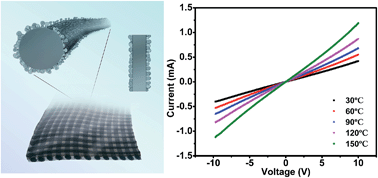Fabrication of ultrathin conductive protein-based fibrous films and their thermal sensing properties†
Abstract
For the first time, ultrathin polypyrrole/protein fibrous films have been successfully fabricated by polymerizing pyrrole onto three-dimensional electrospun hordein network surfaces at a low temperature. The nanostructured polypyrrole is rooted on the surface of protein microfibers like “taste buds”. Such modification not only eliminated the issue of protein shrinkage in the liquid medium, but also significantly improved the film's mechanical strength and wettability. The ultrathin fibrous films exhibited a “metallic” character, and could effectively respond to temperature changes, and thus have potential to be used as flexible materials for sensors and electronic devices.


 Please wait while we load your content...
Please wait while we load your content...